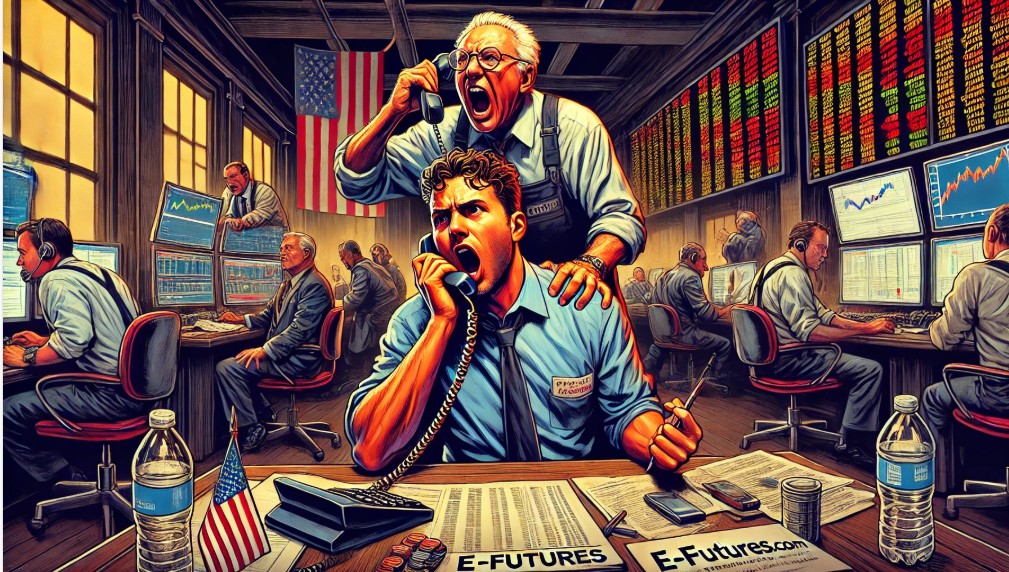In the dynamic world of financial markets, trading futures has become a cornerstone for institutional and retail investors alike. Amid economic uncertainty, heightened geopolitical tensions, and the resurgence of protectionist policies such as President Trump’s global tariffs in 2025, market participants are seeking not only profitable opportunities but also robust risk management strategies. This comprehensive paper explores key aspects of futures trading, including five trading techniques to mitigate risk during recessions, the strategic role of futures brokers, and why partnering with a platform like E-Futures.com and its proprietary CannonX is a game-changing decision for traders. We will also assess how traders can utilize the VIX index to gauge market sentiment and position themselves accordingly.
The Role of Futures Trading in Modern Markets
Trading futures is a derivative-based investment strategy that involves contractual agreements to buy or sell an asset at a predetermined price on a future date. These assets range from commodities like crude oil and gold to financial instruments like indices and Treasury bonds. Futures are leveraged instruments, which means they require only a margin deposit to control a much larger position, amplifying both potential profits and losses.
Futures markets serve several key purposes: hedging, speculation, and price discovery. In times of economic volatility or downturns such as recessions, futures trading becomes an essential tool for managing risk exposure across a diversified portfolio. Futures contracts offer a high level of liquidity and are standardized, providing transparency and ease of execution. However, this volatility demands disciplined strategies and support from the best futures brokers.
Five Trading Techniques to Mitigate Risk in Times of Recession
1. Hedging With Inverse Futures Contracts
One of the most effective techniques in trading futures during a recession is hedging. Investors can use futures contracts that move inversely to their current holdings. For example, if a trader holds equities expected to decline, shorting an index futures contract such as the S&P 500 can offset losses. This strategy protects capital while maintaining exposure to potential rebounds.
2. Utilizing Spread Trading Strategies
Spread trading involves taking opposite positions in two related futures contracts, such as calendar spreads or inter-commodity spreads. This technique reduces directional risk and capitalizes on relative price movements. During recessions, volatility between correlated assets often increases, making this strategy particularly effective.
3. Position Sizing and Leverage Control
Managing position size is critical in futures trading due to the leverage involved. Traders should reduce their exposure during uncertain economic times by lowering the number of contracts and tightening margin requirements. This reduces the risk of forced liquidations and preserves trading capital.
4. Implementing Stop-Loss and Trailing Stops
Stop-loss orders limit the maximum loss on a trade, while trailing stops help lock in profits by adjusting the stop price as the market moves favorably. These risk management tools are indispensable in a volatile recessionary environment, where rapid price swings can jeopardize open positions.
5. Diversifying Futures Portfolios
Instead of concentrating on a single sector, diversifying across various futures markets such as commodities, indices, currencies, and interest rates can mitigate systemic risks. Economic recessions affect sectors differently, and a diversified approach helps cushion losses in underperforming areas.
How Futures Brokers Facilitate Strategic Market Moves
The best futures brokers play an instrumental role in executing these risk-mitigation strategies effectively. Professional brokers provide vital market insights, real-time data, and access to advanced trading platforms that enhance decision-making. Here’s how brokers facilitate such strategies:
- Real-Time Execution and Market Access: Brokers ensure seamless execution and access to global exchanges, which is critical for timely hedging and spread trades.
- Advisory Services: Many brokers offer direct consultations with experienced professionals who guide clients through market cycles and trading decisions.
- Advanced Risk Management Tools: Brokers provide access to platforms equipped with risk analysis, charting, and automated trading capabilities.
- Education and Support: From webinars to daily reports, top brokers equip traders with the tools and knowledge to adapt to changing market conditions.
This is where E-Futures.com and their CannonX trading platform truly stand out, offering traders more than just transactional support.
The Impact of President Trump’s Global Tariffs on Futures Trading in 2025 Q2
With President Trump’s reinstated tariffs reshaping global trade in 2025, futures trading is experiencing increased volatility. These tariffs, imposed on key trading partners such as China, Germany, and Mexico, are disrupting global supply chains, increasing the cost of imports, and impacting sectors such as manufacturing, agriculture, and technology.
Expected Market Reactions in Q2 2025:
- Commodities Volatility: Agricultural futures, especially soybeans and corn, are reacting to retaliatory tariffs and trade embargoes. Traders are using these contracts for speculative opportunities and hedging.
- Currency Futures Surge: As global currencies adjust to tariff impacts, currency futures like the Euro and Yuan are seeing heightened activity. Traders anticipate continued swings and use these contracts to position against the U.S. dollar.
- Equity Index Futures Adjustment: S&P 500 and Nasdaq futures are fluctuating amid uncertainty around corporate profits and inflation. Traders are turning to mini and micro contracts to manage risk more granularly.
- Metals and Energy: Tariff-related inflation fears are driving gold futures upward, while energy futures react to geopolitical shifts in oil production.
Smart futures trading participants are leveraging these disruptions through tactical positioning, with guidance from seasoned brokers and reliable platforms.
Utilizing the VIX Index in Today’s Trading Environment
The VIX Index, also known as the “fear gauge,” measures expected volatility in the S&P 500 over a 30-day horizon. In times of economic or political turmoil, VIX tends to spike, signaling increased market anxiety.
How Traders Use the VIX:
- Sentiment Indicator: VIX trends help traders assess the overall mood of the market. Elevated VIX levels often signal market bottoms, while complacency suggests possible tops.
- Volatility-Based Strategies: Traders use VIX futures and options to speculate or hedge against volatility. For instance, rising VIX levels during tariff announcements create opportunities to profit from volatility surges.
- Correlation Assessment: By analyzing the VIX alongside other futures contracts, traders identify potential reversals or continuation patterns.
- Risk Management: When VIX levels are high, traders adjust leverage and tighten risk controls to safeguard capital.
Integrating VIX analysis into a broader futures trading strategy enhances a trader’s ability to adapt in real-time to changing market conditions.
Why E-Futures.com is one of the Best Futures Brokers in 2025
When it comes to navigating turbulent markets, E-Futures.com and their CannonX platform stand out as among the best futures brokers for several compelling reasons.
Unmatched Customer Service
Forget automated bots and endless phone menus. With E-Futures.com, traders are instantly connected with a seasoned broker—a real human with decades of market experience. Whether you need help placing a trade or assessing a macroeconomic shift, expert assistance is only a call away.
Five-Star TrustPilot Rankings
With numerous 5 out of 5-star reviews on TrustPilot, E-Futures.com has earned a reputation for excellence, integrity, and responsiveness. These accolades highlight the company’s commitment to client satisfaction and trustworthiness, essential traits in uncertain times.
Free Access to CannonX and Other Platforms
The CannonX platform, exclusive to E-Futures.com, is free and designed with both novice and professional traders in mind. It offers:
- Advanced charting and analysis tools
- Real-time quotes and news
- Automated trading systems
- Seamless order execution
In addition to CannonX, E-Futures.com offers a wide selection of other free platforms tailored to different trading styles and needs, ensuring every client has the tools to succeed.
Regulatory Excellence
E-Futures.com maintains an exemplary standing with all major industry regulators, including the NFA and CFTC. This ensures transparency, ethical conduct, and compliance with the highest standards.
Educational and Strategic Resources
Beyond technology and service, E-Futures.com equips traders with educational materials, daily research updates, and access to broker insights. This empowers clients to make informed decisions and improve over time.
Historical Analysis: How Futures Trading Evolved During Past Recessions
Looking back at previous recessions provides valuable context for how trading futures performs under economic pressure. During the 2008 financial crisis, for example, futures contracts in precious metals and Treasury bonds saw a surge in activity as investors sought safe-haven assets. Similarly, agricultural futures displayed volatility due to commodity pricing instability.
In 2020, the COVID-19 pandemic led to an unprecedented collapse in crude oil futures, where prices briefly turned negative. This highlighted the importance of risk controls, diversified asset classes, and vigilant broker support. In both instances, the best futures brokers proved invaluable by offering timely market insights and tools for adaptive strategies.
Advanced Strategy Spotlight: Algorithmic Futures Trading
As technology evolves, many traders are turning to algorithmic trading systems to enhance their performance. Platforms like CannonX support algorithmic models that automate trade entries and exits based on predefined criteria such as price movements, volume thresholds, or volatility levels.
Benefits of Algorithmic Trading:
- Speed and Efficiency: Orders are executed faster and without emotional bias.
- Backtesting Capabilities: Traders can test strategies on historical data to assess viability.
- Consistency: Algorithms maintain discipline and follow rules even during turbulent conditions.
With guidance from the best futures brokers like E-Futures.com, traders can integrate these systems with minimal friction, creating a hybrid approach that blends automation with human oversight.
The Psychological Edge in Futures Trading
Market volatility often tests a trader’s emotional resilience. Recession-driven fear and overconfidence during rallies can derail even the most robust strategies. The best futures trading strategies account for these emotional biases.
Techniques for Developing the Right Trading Mindset:
- Routine and Discipline: Set daily review schedules, trade planning, and journaling.
- Risk Acceptance: Understand and be comfortable with the probability of losses.
- Continuous Learning: Attend broker-hosted seminars and updates.
Platforms like CannonX provide journaling tools, performance metrics, and feedback analytics to help traders evolve and maintain a psychological edge.
In a world fraught with economic uncertainty, global trade disruptions, and volatile financial markets, trading futures remains a powerful and versatile strategy. With the right techniques, such as spread trading, hedging, and volatility analysis, traders can mitigate risks and find opportunities even in recessions. But success in futures trading doesn’t rely solely on strategy—it depends on the strength of the partnership with a trusted broker.
E-Futures.com, alongside its robust CannonX platform, embodies the gold standard of customer service, platform performance, regulatory compliance, and educational support. Whether you’re a seasoned investor or just beginning your trading futures journey, aligning with one of the best futures brokers like E-Futures.com provides the edge needed to thrive in today’s fast-paced markets.
To open an account with E-Futures.com, please click here.
Top of FormReady to start trading futures? Call US 1(800)454-9572 – Int’l (310)859-9572 email info@cannontrading.com and speak to one of our experienced, Series-3 licensed futures brokers and start your futures trading journey with E-Futures.com today.
Disclaimer – Trading Futures, Options on Futures, and retail off-exchange foreign currency transactions involves substantial risk of loss and is not suitable for all investors. Past performance is not indicative of future results. You should carefully consider whether trading is suitable for you in light of your circumstances, knowledge, and financial resources. You may lose all or more of your initial investment. Opinions, market data, and recommendations are subject to change at any time.
Important: Trading commodity futures and options involves a substantial risk of loss. The recommendations contained in this writing are of opinion only and do not guarantee any profits. This writing is for educational purposes. Past performances are not necessarily indicative of future results.
**This article has been generated with the help of AI Technology. It has been modified from the original draft for accuracy and compliance.
Follow us on all socials: @cannontrading(Instagram)








